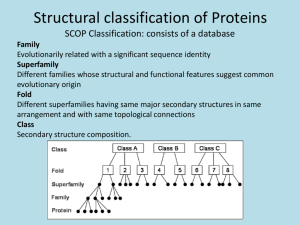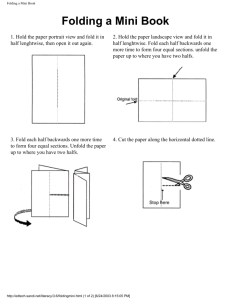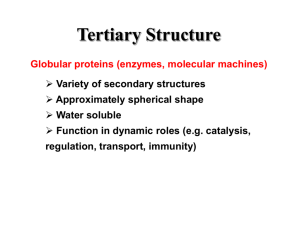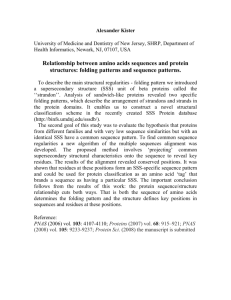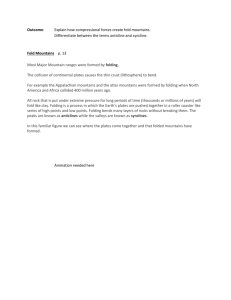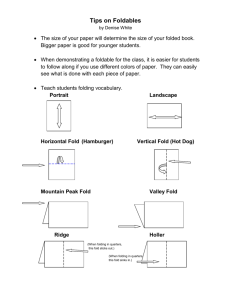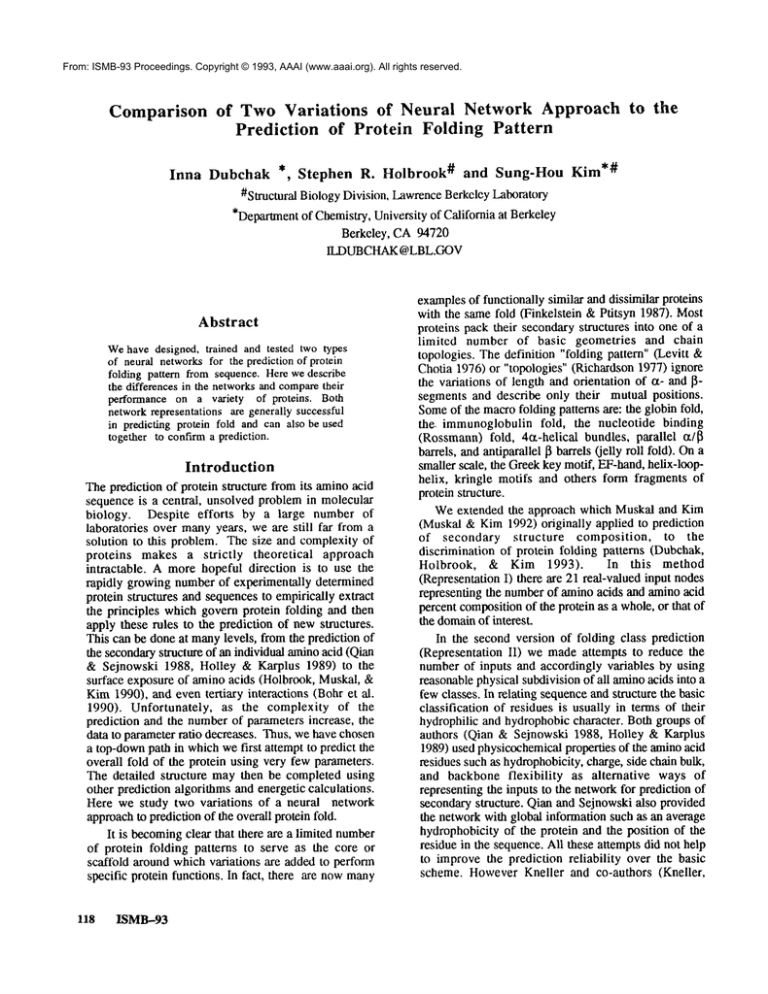
From: ISMB-93 Proceedings. Copyright © 1993, AAAI (www.aaai.org). All rights reserved.
Comparison of Two Variations
of Neural Network Approach to the
Prediction of Protein Folding Pattern
Inna
Dubchak
*,
Stephen
R. Holbrook
# *#
and Sung-Hou
Kim
#Strnctural Biology Division, LawrenceBerkeley Laboratory
*Departmentof Chemistry, University of California at Berkeley
Berkeley, CA 94720
II.X)UBCHAK @LBL.GOV
Abstract
Wehave designed, trained and tested two types
of neural networksfor the prediction of protein
folding pattern from sequence. Here we describe
the differences in the networksand comparetheir
performance on a variety of proteins. Both
networkrepresentations are generally successful
in predicting protein fold and can also be used
together to confirma prediction.
Introduction
The prediction of protein structure from its aminoacid
sequence is a central, unsolved problem in molecular
biology. Despite efforts by a large number of
laboratories over manyyears, we are still far from a
solution to this problem. The size and complexity of
proteins makes a strictly
theoretical
approach
intractable. A more hopeful direction is to use the
rapidly growing number of experimentally determined
protein structures and sequences to empirically extract
the principles which govern protein folding and then
apply these rules to the prediction of new structures.
This can be done at manylevels, from the prediction of
the secondarystructure of an individual aminoacid (Qian
& Sejnowski 1988, Holley & Karplus 1989) to the
surface exposure of amino acids (Holbrook, Muskal,
Kim1990), and even tertiary interactions (Bohr et al.
1990). Unfortunately,
as the complexity of the
prediction and the numberof parameters increase, the
data to parameter ratio decreases. Thus, we have chosen
a top-downpath in whichwe first attempt to predict the
overall fold of the protein using very few parameters.
The detailed structure may then be completed using
other prediction algorithms and energetic calculations.
Here we study two variations of a neural network
approachto prediction of the overall protein fold.
It is becomingclear that there are a limited number
of protein folding patterns to serve as the core or
scaffold around which variations are added to perform
specific protein functions. In fact, there are nowmany
118
ISMB-93
examplesof functionally similar and dissimilar proteins
with the same fold (Finkelstein & Ptitsyn 1987). Most
proteins pack their secondary structures into one of a
limited number of basic geometries and chain
topologies. The definition "folding pattern" (Levitt
Chotia 1976) or "topologies" (Richardson 1977) ignore
the variations of length and orientation of ¢t- and 13segments and describe only their mutual positions.
Someof the macrofolding patterns are: the globin fold,
the. immunoglobulin fold, the nucleotide binding
(Rossmann) fold, 4o~-helical bundles, parallel t~/~
barrels, and antiparallel ~ barrels (jelly roll fold). On
smaller scale, the Greekkey motif, EF-hand,helix-loophelix, kringle motifs and others form fragments of
protein structure.
Weextended the approach which Muskal and Kim
(Muskal & Kim1992) originally applied to prediction
of secondary structure
composition,
to the
discrimination of protein folding patterns (Dubchak,
Holbrook,
& Kim 1993).
In this
method
(Representation I) there are 21 real-valued input nodes
representing the numberof amino acids and amino acid
percent compositionof the protein as a whole, or that of
the domainof interest.
In the second version of folding class prediction
(Representation II) we made attempts to reduce the
number of inputs and accordingly variables by using
reasonable physical subdivision of all aminoacids into a
fewclasses. In relating sequenceand structure the basic
classification of residues is usually in terms of their
hydrophilic and hydrophobic character. Both groups of
authors (Qian & Sejnowski 1988, Holley & Karplus
1989) used physicochemicalproperties of the aminoacid
residues such as hydrophobicity,charge, side chain bulk,
and backbone flexibility
as alternative
ways of
representing the inputs to the networkfor prediction of
secondary structure. Qian and Sejnowski also provided
the networkwith global information such as an average
hydrophobicity of the protein and the position of the
residue in the sequence. All these attempts did not help
to improve the prediction reliability over the basic
scheme. However Kneller and co-authors (Kneller,
Cohen, & Langridge 1990) used the scheme with
additional
helix hydrophobic moment and strand
hydrophobic momentinput units which improved the
testing statistics slightly in comparison with (Qian
Sejnowski 1988).
Basically there are two opposite viewpoints (with
variety of opinions in between) regarding the
distribution of hydrophobicand hydrophilic sites along
the sequence of protein. Chothia and Finkelstein
(Chothia & Finkelstein
1990) proved that this
distribution is uniquein the ease of the globin sequence.
The formation of the native secondary structure of any
protein brings together sites of the same character to
form hydrophobic and hydrophilic surfaces. Protein
interiors are occupied mainly by non-polar residues and
occasionally by neutral residues. The polar atoms in
neutral residues usually form hydrogen bonds within
their ownsecondary structures so the surfaces between
secondary structures are almost entirely hydrophobicin
character. Theconverse is also true: the sites in protein
that are highly exposedto the solvent are nearly always
occupied by polar or neutral residues. The same is
supposedlytrue for other folds. Since an architecture of
a definite fold is specific feature it is reasonableto use
this kind of classification for neural net input.
Local interactions inside structural segments can
often determine the protein secondarystructures despite
the presence of muchstronger long range interactions
between different segments. Someof the hydrophobicity
scales (Ponnuswamy1993) takes into account protein
structural class information namelythe environment of
each amino acid residue when estimating
its
hydrophobicity. The other scale (optimal matching
hydrophobicity ) was derived on the assumption that
families of proteins that fold in the same way, do so
because they have the same pattern of residue
hydrophobicities along their amino acid sequences
(Eisenberg 1984).
At the same time, White and Jacobs (White
Jacobs 1990) studied the statistical
distribution of
hydrophobicresidues along the length of protein chains
using a binary hydrophobicity scale which assigns
hydrophobic residues a value of one and nonhydrophobes a value of zero. The resulting binary
sequences are tested for randomnessusing the standard
run test. For the majority of the 5,247 proteins
examined,the distribution of hydrophobicresidues along
a sequence cannot be distinguished from that expected
for a randomdistribution. The authors suggest that (a)
functional proteins may have originated from random
sequences, (b) the folding of proteins into compact
structures may be much more permissive with less
sequencespecificity than previously thought, and (c) the
clusters of hydrophobicresidues along chains which are
revealed by hydrophobicity plots are a natural
consequence of a random distribution
and can be
conveniently described by binomial statistics.
In our calculations we used a less simplistic
classification
than White and Jacob, and made an
attempt not only to group the residues accordingto their
relative hydrophobicity, but to take into consideration
their immediateenvironment.
Several scales for classification of hydrophobichydrophilic character of residues have been published.
Most of these scales differ only in details and so show
high correlation. Weused the hydrophobicity groups
from (Chothia & Finkelshtein 1990), which are very
similar to those of consensus scale (Eisenberg 1982),
which was designated to mitigate the effect of outlying
values in any one scale producedby the peculiarities of
the method.
Methods
Database: A critical problem in classification
of
protein folding types by neural networks is the limited
numberof protein examples of knownthree-dimensional
structure. Wehave partly overcome this problem by
using the much larger protein sequence database.
Proteins of the same family from different organisms,
showing high sequence homology with proteins of
known
structure were assumedto have the same overall
folding pattern and were used to greatly increase the
number of input examples for use in network training
and testing. Thus, we selected the proteins for whichthe
crystal s~ucture is knownto have the fold of interest
and then retrieved homologous proteins from the
SWlSS-PROTsequence database. We chose to begin
our studies on four diverse folding patterns for which
there exists a relatively
large number of known
structures and sequence analogs. Other folding motifs
can easily be addedto the prediction schemeas sufficient
examplesof knownstrnctttre are characterized.
S011, in some cases the number of variable
parameters did not exceed the number of independent
observations whichled to a lack of generalization. This
problem, in turn, led to our experiments with an
alternate input representation specified by fewer
parameters.
Protein structure
information was from the
BrookhavenProtein Data Bank (Bernstein et al. 1977)
(PDB)and publications describing proteins of known
crystal structure but not yet deposited in the Brooldaaven
PDB. Sequence information was from the Swiss-Prot
database (SP) Release 20 (Bairoch &Boeckmann1991).
Therefore, databases were compiled for each of the
following folding patterns 1) 4(x-helical bundles
(BUNDLE),2) Eight stranded parallel (x/~ barrels
(BARREL),3) Nucleotide binding or Rossmann (NBF)
fold, 4) Immunoglobulin fold (IGF) and 5) other
unclassified (UNC)folds. A full list of used protein
sequences and structures is presented in (Dubchak,
Holbrook, & Kim 1993). The number of proteins in
each database and average characteristics for each class
Dubchak
119
are given in Table 1. Ribbondrawings of representative
proteins from each of the four folding patterns are
shownin Figure l(a-d).
For single domain proteins, only sequences for
which the folding pattern of interest comprised more
than 50%of the total sequence were used. In the case of
multidomain proteins, sequences of a domainwere used
when the pattern of interest accounted for more than
50%of that domain, even though the overall percentage
of the total protein was less than 50%.Only the single
domain of. multidomain proteins that contained the
folding pattern of interest, wasused in our studies.
Neural Networks: The architecture of the networks
is shownin Figure 2. The neural networks used in this
study were of the feed forward type with either zero
(perceptron) or one hidden layer and weights adjusted
conjugate gradient minimization using the computer
program package BIOPROP(Muskal & Kim 1992).
The protein sequences were converted to 21 numbers
(percent composition of amino acids and number of
aminoacids in a sequence)in Representation I, or seven
(hydrophobic composition) numbers in Representation
II. The hydrophobic composition characteristics are:
numberof aminoacid residues in the sequence; overall
percent composition of polar residues (Arg, Lys, Glu,
Asp, Gin, and Asn); overall percent composition of
neutral residues (Gly, Ala, Ser, Thr, Pro, His, and Tyr);
overall percent composition of hydrophobic residues (
Cys, Val, Leu, Ile, Met, Phe, and Trp); number of
sequential transitions from polar to neutral, from polar
to hydrophobic, and from neutral to hydrophobic
residues. Technically all values were normalized for
better convergenceduring an optimization of neural net
weights.
In the networks utilizing
percent amino acid
composition (as well as numberof residues) as input,
no single amino acid percentage was seen to be
significantly different amongthe different classes.
Likewise, in the networks using hydrophobic
composition as input it is apparent that no single
characteristic out of 7 for any of 4 folding classes is
significantly different.
As illustrated in Figure 2, networks of from one to
four outputs were used to classify a protein into one of
the four folding patterns or as "other". Whenone
output node is used, the choice is betweena particular
fold and all others. As additional nodes are added the
network makes a decision between the various output
patterns, with a low activity to all outputs indicating
"other", or that the fold of interest does not correspond
to any of the available choices.
Eachof the four databasesfor different folding classes
was separated into independenttraining and testing sets,
i.e. no protein family from training was included in
testing. This was necessary because each database
contains a large numberof similar (but not identical)
examples and therefore random sampling will perform
120
ISMB-93
very well simply because of memorization. For each of
the four databases, at least twodifferent training-testing
set combinationswereconstructed so as to test the effect
of specific proteins on training/testing.
The same
operation was made for a combined sets of two, three
and four folding classes representatives. This procedure
is described in detail elsewhere (Dubchak,Holbrook,
Kim 1993).
In order to optimize the numberof hidden nodes for
each particular training-testing
set combination,
networks containing from 0 to 9 hidden nodes were
systematically trained and tested numeroustimes to find
the architecture which gave the best performance in
predicting the testing set. The networks with the
optimal number of hidden nodes were then trained
repeatedly (10 times) from random initial starting
weights to search more completely the parameter space
and the weights producing the highest testing scores
were chosen as the "optimal network weights". One
hundred cycles of conjugate gradient minimization was
found optimal to provide maximalgeneralization (best
training without memorization)for most of the sets and
wasthus used in all training.
Results
The results of network testing for each of the four
folding classes with from one to four output nodes are
summarizedin Table 2. Thus, there are four types of
trained networks for each representation, each makinga
prediction as to whether a protein contains a specific
folding pattern. At least two separate training-testing
sets wereconsideredfor each folding pattern.
As can be seen from Table 2, both approaches give
fairly reliable results for all the groups of proteins. In
some cases Representation II shows an improvementin
prediction comparedto Representation I, especially in
distinction betweenfolding classes 1/3, 2/3, 1/3/4, and
1/2/3. However, in some cases performance became
worse, as in the case of class 1 prediction and distinction
between classes 1/2, 2/4 and 1/2/4. Thus, we propose
that for maximum
confidence of prediction, each given
sequence should be tested sequentially on all 30
networks, namely on 15 networks for each of the two
Representations - four networks with 1 output node, six
2 output node networks representing all possible
pairwise combinations of 4 classes, four 3 output
networks allowing assignment of the sequence to one of
three folds and 1 net with 4 outputs which makes a
decision between all available folding classes. Each
network gives one integer number (1-4 for known
classes and 5 for unclassified) indicating the most
favorable type of folding. Eachfolding class participates
in 8 nets (per Representation), so the maximum
number
of predictions for each class is 8, if the results of all
testings are in accordance. Tests have shownthat the
fold is strongly predicted if the number of positive
predictions for this particular fold is equal to or greater
Table1. Characteristicsof protein databaseused in this study
Folding NumberNumberAv. % composition of residues Av. number of sequential
class* of crystal of amino in database / stand, deviations transitions**/st, dev.
s~ acids
in Polar
Neutral Hydrophobic
examples sequem~
Swiss-Prot
P
N
H
P-N
P-H
N-H
Avemge%/St.dev.
a-helices 13-strands
I
12/68
103232
33.6/3.8 36.0/4.9 30.5/3.9
24.6/3.8 21.0/3.6 21.92.9
70.3/2.9
0.0/0.0
II
8/92
194394
30.3/1.5 39.4/2.0 30.2/1.7
22.9/2.3 18.1/2.6 25.1/2.8 45.3/5.7
III
10/167
171 374
30.4/3.9 37.1/3.5 32.6/2.5
22.0/3.1 20.4/2.4 23.1/4.5 36.3/10.1 16.1/4.5
IV
91180
105400
24.3/3.3 46.3/2.8 29.4/0.8
20.612.7 18.2/1.9 27.1/3.5 7.1/4.5
15.3/5.7
44.1/4.7
I - 4et-helical bundle; II -Parallel o./1~ barrels; III - Nucleotidebinding or Rossmann
; IV - Immunoglobulin
Normalizedby division on numberof aminoacids in a protein
Dubchak
121
a)
b)
c)
d)
Figure 1.
Schematic drawings of membersof the four folding patterns predicted, a)
Four or-helical bundle fold (BUNDLE):
The specific example shown is Myohemerythrin
(PDBcode: 2MHR,
118 aminoacids); b) Eight stranded parallel (oil3) bah’el (BARREL):
The specific example shownis: Tfiosephosphate isomerase (PDBcode: 1TIM, 248 amino
acids); c) Nucleotide binding or Rossmannfold (NBF): The specific exampleshown
Adenylate kinase (PDBcode: 3ADK,194 amino acids); d) Immunoglobinfold (IGF):
specific example shown is the variable portion of the Bence-Jones immunoglobin(PDB
code: 1REI, 107 amino acids). Arrowsrepresent I]-strands and coils represent helical
regions.
122
ISMB-93
REPRESENTATION
II
Hydrophoblclty,
Numbers Defined Relative
Number of Residues
Percent Composition and
©©
Input Layer
7 nodes
Hidden Layer
0-1 0 nodes
Patterns
I
Output Layer
1-4 nodes
®
¯
A
C
D
E
@
Hidden Layer
O- 1 0 nodes
Input Layer
21 nodes
@
y
#
Amlno Acld Composltlonand Total Number of Residues
REPRESENTATION
I
Figure 2.
Schematicdiagramof the architecture of the computationalneural networks
discussedin the text. Thecircles representcomputationalnodesandthe lines correspondto
weightedlinks betweenthe nodes.
Dubchak
123
Table 2. Examplesof performance of independent testing sets for
Representations I &II.
Fold
Numberof Groups of
proteins
outputs
in testing
set*
Number
of examples
in training/
testing sets
Percent of knownproteins in testing set predicted
correct
Prediction based on Prediction based on relative
percent composition hydrophobicity
RepresentationI
RepresentationII
1
2
3
4
1
1
1
1
A
B
C
D
122/14
124/32
320/55
174/76
100
81.2
86.6
65.7
71.4
100
89.6
77.5
1/2
1/3
1/4
2/3
2/4
3/4
2
2
2
2
2
2
E,F
E,C
E,D
B,H
B,D
C,I
120/16
134/18
151/20
149/28
178/28
178/28
100/88.9
87.5/60.0
50.0/100
81.2/91.6
100/100
100/89.2
88.9/61.5
100/87.5
70.2/93.0
100/100
92.8/85.7
100/92.3
1/2/3
1/3/4
2/3/4
1/2/4
3
3
3
3
G,B,K
E,K,D
B,K,D
E,B,D
179/36
205/33
209/36
205/30
61.5/81.8/83.3
72.7/85.7/100
54.5/100/76.9
88.8/90.9/63.6
69.2/90.9/83.3
85.7/85.7/100
72.7/100/72.7
77.7/90.9/72.7
E,F,G,I
290/41
62.5/100/75.0/69.2
75.0/87.5/75.0/76.9
1/2/3/4 4
* Independent groups of proteins were separated into testing sets: A. M-CSF,GM-CSF,
G-CSF;
B. Aldolase; C. Lactate dehydrogenase;D. T-cell surface glycoprotein; E. Tar(asp) receptor,
cytochromeB-562, hemerythrin; F. D-xylose isomerase; G. Lactate dehydrogenase; H. RABproteins;
I. Histocompatibility antigen, class 1; G. CytochromeC’; K. Glyceraldehyde-3-phosphatedehydrogenase;
124
ISMB-93
than 6 out of 8 and no more than 4 networks predict
another fold; a weakprediction is defined as 5 out of 8
positive predictions per Representation.
After sequential testing on 30 nets we compare
predictions by the two methodsand judge them reliable
whenthey are in accordance, even when one of them is
weak. However,if a prediction of protein fold by at least
one method is strong we can use this as a first
approximation and take into consideration other
chemical and biochemical information. For example, the
testing of five interleukin 2 cytokines (Bairoch
Boeckmann1991) from different organisms gives
strong indication of BUNDLE
fold by Representation I,
namely 3 nets with 2 outputs and 3 nets with 3 outputs
assign these molecules to this fold but 1 output nets
recognize them as Rossmannfold and 4 output net as
UNKNOWN.
Representation
II gives only a weak
indication of the samefold (1 by the single output nets,
two by 2 output nets and two by 3 output nets). We
believe that a final prediction of this fold as BUNDLE
is
reliable based on a hybrid strategy.
In order to learn strengths and weaknesses of both
Representations, we undertook testing of 250 proteins
from the BrookhavenProtein Databank (Bemstein et al.
1977). The advantage of these testing samples was
knowntertiary structure which allowed us to evaluate
where either one or both methodsdon’t work.
Since it has been demonstrated (Muskal & Kim
1992) that neural networks can accurately predict
secondary structure composition from amino acid
percentage, wefelt it importantto verify that the folding
pattern predictions were not just reflecting this ability.
In the group of 19 proteins of high alpha-helix (>50%
alpha-helix) which we tested, only 3 of them were
incorrectly predicted by two methods as belonging to
BUNDLE
fold. They are: DNAbinding regulatory
protein (1WRPcode in Protein Databank) with a fold
consisting of 6 non-parallel helices, cytochrome C2
(code 2C2C,5 helices in structure) and calcium-binding
parvalbumin (4CPV, 6 helices). No protein which was
not high in helical content was predicted as a 4¢z-helical
bundle. In the case of myohemerythrin the fold is
correctly predicted as BUNDLE
only by Representation
II. Based on these examples, the presence of cofactors
(three of the four cases) in the structure maydisturbs
prediction, probably because of the special aminoacids
necessaryfor cofactor ligation.
The importance of a combined approach is obvious
in the prediction of the ct-chain of globins (1FDH,
1HBS,1HDS, 1PMB,1ECDin the Protein Data Bank).
After correction of the neural network weights by
addition of an extra node for the presence or absence of
the hemecofactor, still three out of five proteins were
incarcerate predicted as BUNDLE
by Representation 1,
but all five of them assigned to UNKNOWN
fold by
Representation II. The group of globins might be the
next candidate for addition to our schemeof prediction
because of significant numberof knownstructures for
training.
Asfor proteins with very low or zero helical content,
they are sometimesincorrectly predicted as belongingto
the immunoglobulin fold. Examples are: hydrolase
(1RNT), containing 16%helix and 56%strand, alphabungarotoxin (2ABX)- 0 and 89% and actinoxanthin
(1ACX)- 0 and 56%. This reflects a prejudice in the
networks to classify
low helical proteins as
immunoglobinfold, likely due to a lack of proteins of
other folding patterns with low helix content which
could be used as fak~e examples.
Wecan classify all failures into two groups - those
which assign a protein to a definite folding class to
which it does not belong and those which lack the
ability to recognize folding pattern and therefore
classify a protein as belonging to unknownfold. While
we have observed incorrect assignment to each of the 4
folds we havestudied, the (¢x13)8 barrel folding motif is
the one which most often gives ambiguousresults.
The prediction of the BARREl.fold presents a
situation which needs moredetailed analysis. Structures
of aspartate aminotransferase (2AAT),leucine-binding
protein (2LBP), dihydrofolate reductase (4DFR)
phosphofructokinase (3PFK) represent combinations
helices and strands in approximately the same
quantitative relation as in (¢x13)8 barrels, but with
different relative position of helices and strands. Still,
all of them were predicted as BARRELby both
Representations. The commonfeatures of all of them
are percent compositionof helices and strands is close to
those of barrel structures and numberof helical and
strand fragmentin structure is not less than 8 for both,
sometimes 10 and more. Another source of confusion
arises from the prediction of multidomainproteins. So,
the two-domain structures of L-arabinose-binding
protein (1ABP)and rhedanese (1RHD)were classified
(ot[3) barrels by both methods. However, when
predictions were made on the individual domains of
these proteins no one network gives such a prediction
and the conclusion can be made that they belong to
unclassifiedfold.
In the case of NBF and BARRELprediction,
incorrect results with both Representations have been
obtained on some mixed ~ structures. For example,
lysozyme (2LZM) was incorrectly,
but strongly,
predicted as a nucleotide binding fold by Representation
I and correctly as unknownby Representation II. Other
members of the lysozyme family (1LYM,1LZT) were
predicted as unknown by Representation
I, but
incorrectly as BARREl.by Representation II. Another
memberof the family (1LZ2)was correctly predicted
UNKNOWN
by both Representations. This emphasizes
the importance of examining several members of a
family whenpossible.
Dubchak
125
Conclusions
Wehave designed and implemented two types of neural
networks for the prediction of protein folding pattern
from sequence. The input representations in these two
network types utilize a different numberof parameters
and contain a different
level of information.
Representation I, which requires about three times the
number of variable parameters maybe able to pick up
specific features characteristic of certain folding types.
On the other hand Representation II should be superior
in prediction by generalization or extrapolation. For the
most reliable prediction each of these methods should
consistently predict the same fold, whether using one,
two, three or four outputs and the two representations
should agree with each other.
Several points should be kept in mind when
predicting protein fold using the networks described
above: 1) it is very important to use only the sequence
of a single domainin makingthe prediction (because we
are only predicting a domainstructure), 2) the method
applicable to proteins of size range 100-400 amino
acids, since this is the range of the proteins used in
training and 3) testing of several membersof a protein
family can greatly increase reliability of results and
should be attempted whenever possible. Weare in the
process of automating protein family prediction and
expect the prediction accuracyto be greatly increased.
Finally, another approach to checking the predicted
modelis to look for consistency with other predictions
of protein structure.
With this in mind we have
developed an integrated neural network package for
protein structure prediction. This program package,
which we call PROBE
(PROtein prediction at BErkeley)
(Holbrook, Dubchak, & Kim 1993 ), not only makes
predictions of the folding pattern by the two methods
discussed above, but also compares them with the
secondary structure predictions by the method(Qian
Sejnowski 1988) and a modified version of the networks
of Holley and Karplus ( Holley & Karplus 1989 ),
well as the overall secondary structure composition
(Muskal & Kim 1992). Agreement of these various
networks leads to a high confidence in protein fold
prediction.
References.
Bairoch, A; and Boeckmann, B. 1991. The SWISSPROT sequence data bank. Nucl. Acids. Res. 19
Suppl.: 2247-49.
Bernstein, F.C.; Koetzle, T.F.; Williams, G.J.B.;
Meyer, E.F_I.; Brice, M.D.; Rodgers, J.R.; Kennard,
O.; Shimanouchi, T.; and Tasumi, M. 1977. The
Protein Data Bank: A Computer-base Archival File for
Macromolecular Structures. J. Mol. Biol. 112: 535542.
126 ISMB--93
Bohr, H.; Bohr, J.; Brunak, S.; Cotterill, R.M.J.;
Fredholm, H.; Lautrup, B.; and Petersen, S.B. 1990. A
novel approach to prediction of the 3-dimensional
structures of protein backbones by neural network.
FEBSletters. 261(1): 43-46.
Chothia, C.; and Finkelstein, A.V. 1990 .The
classification and origins of protein folding patterns.
Annual Review of Biochemistry 59: 1007-39.
Dubchak, I.; Holbrook, S. R.; and Kim, S.-H. 1993.
Prediction of Protein Folding Class from AminoAcid
Composition. Proteins: Structure, Function, and
Genetics. Forthcoming
Eisenberg, D. 1984. Three-Dimensional Structure of
Membraneand Surface Proteins. Annu. Rev. Biochent
53: 595-623.
Eisenberg, D.; Weiss, R.M.; and Terwilliger, T.C.
1982. HydrophobicMomentand Protein Structure.
Faraday Syrup. Chem. Soc. 17: 109-120.
Finkelstein, A.V.; and Ptitsyn, O.B. 1987. WhyDo
Globular Proteins Fit the Limited Set of Folding
Patterns? Prog. Biophys. Molec. Biol. 50: 171-190.
Holbrook, S.R.; Dubchak, I.; and Kim, S.-H. 1993.
PROBE:A Computer Program Employing an Integrated
Neural NetworkApproachto Protein Structure
Prediction. BioTechniques.. Forthcoming.
Holbrook, S.R.; Muskal, S.M.; and Kim, S.-H. 1990.
Predicting surface exposure of aminoacids from protein
sequence. Prot. Eng. 3(8): 659-665.
Holley, UH.; and Karplus, M. 1989. Protein secondary
structure prediction with a neural network. Proc. Natl.
Acad. Sci. USA 86: 152-156.
Kneller, D.G.; Cohen, F.E.; and Langridge, R. 1990.
Improvementin Protein secondary structure prediction
by an enhanced neural network. J. Mol. Biol. 214(1):
171-182.
Levitt, M.; and Chotia, C. 1976. Structural Patterns in
Globular Proteins. Nature 261: 552-557.
Muskal, S.M; and Kim, S.-H. Predicting protein
secondary structure content: a tandem neural network
approach. J. Mol. Biol. 225: 713-727.
Ponnuswamy,P.K. 1993. HydrophobicCharacteristics
of Folded Proteins. Prog. Biophys. Molec. Biol. 59(1):
57-103
Qian, N.; and Sejnowski, T.J. 1988. Predicting the
Secondary Structure of Globular Proteins Using Neural
NetworkModels. J.Mol.Biol. 202: 865-884.
Richardson, J.S. 1977. B-Sheet Topologyand the
Relatedness of Proteins. Nature 268: 495-500, 1977
White, S.H.; and Jacobs, R.E. 1990. Statistical
Distribution of HydrophobicResidues Alongthe Length
of Protein Chains. Implication for Protein Folding and
Evolution. Biophys. J. 54(4): 911-921.


